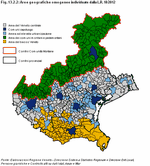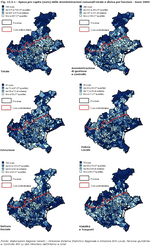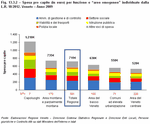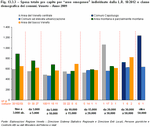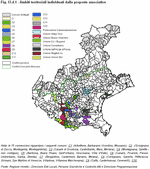Chapter 13
Territorial reorganisation and associated management
The present social-economic situation also requires important decisions from a governance point of view. For a long time, at both a national and regional level, we have been travelling along a road to reforms and transformations that will restructure the entire territory in terms of making the most of public resources. One example of this is the territorial reorganisation plan for the Veneto region that is moving in two directions that are distinct but are interlinked, or the associations between municipalities for the management of the essential functions and the simplification of the governance levels present in the area.
The inter-municipal associations started to develop in 2000 with the implementation of the TUEL legislation (Testo Unico degli Enti Locali, Legislative Decree 267/2000) aimed at reducing the cost of institutional division (small and very small municipalities) and creating territorial areas suitable for managing services. In fact, it is the need to contain costs while maintaining high quality standards for the services offered to citizens, that paved the way along this road to reorganisation.
The inter-municipal associations started to develop in 2000 with the implementation of the TUEL legislation (Testo Unico degli Enti Locali, Legislative Decree 267/2000) aimed at reducing the cost of institutional division (small and very small municipalities) and creating territorial areas suitable for managing services. In fact, it is the need to contain costs while maintaining high quality standards for the services offered to citizens, that paved the way along this road to reorganisation.
From the efficiency of the national legislation ...
The Law Decree no. 78/2010 introduced the obligation for the associated management of the services and essential functions by the municipalities at the national level; the ultimate purpose of this provision is undoubtedly to save money. This aim integrates within a wider framework of anti-crisis and economic competitiveness measures. According to the state legislation, all the Municipalities with up to 5,000 inhabitants (up to 3,000 if they belong to mountain communities) are required to perform the essential functions in an associated form (Note 1). These include:
- the general organisation of the administration, financial and accountancy management and control;
- the organisation of public services of general interest within the municipality, including public transport services;
- land register;
- town and construction planning at the municipal level as well as participation in territorial planning at the supra-municipal level;
- the activity, within the municipality, of planning of civil protection and coordination of the first aiders;
- the organisation and management of collection services, start up, disposal and recovery of urban waste and the collection of the relative taxes;
- the design and management of the local system of social services and its provision to citizens;
- school buildings (where not allocated to the responsibilities of the provinces), the organisation and management of school services;
- the municipal police and local administrative police;
- the services in the statistics field.
... the efficacy of the regional legislation
The Veneto Region implemented these provisions, starting up a restructuration process with the aim of doing more than just passing the obligations introduced: the purpose is that of beginning a thorough territorial reorganisation that is not imposed but chosen, shared and firmly supported by the municipalities. With the aim of both saving money and, above all, ensuring the effective management of municipal services and essential functions: not only the efficiency, as set on a national level, but first of all, the efficacy.With the Regional Law no.18 of 2012 "Discipline of the associated exercise of municipal functions and services", the Veneto Region consequently transformed this compulsory obligation from ultimate aim to important mean in order to achieve a wider result of regional planning. This process will develop according to two phases: the first will see associated management between municipalities with respect to the "rough" indications, that in any case allow an associated management level to be reached which is higher than that outlined by the state legislator; the second, to be considered as "optimal", will see the concrete creation of the optimal territorial dimension, via associated management of greater and more significant effect, with the aim of strengthening the integration of the planning and managing activities for territorial areas of large territorial sizes. Therefore, besides an optimal associated management between municipalities (obligated and not obligated, depending on the state regulation provisions), the effective reduction of governance levels shall occur in accordance with the established guidelines.
As concerns the time scale, the first phase should be carried out with the Regional Council's approval for the territorial reorganization plan. The final territorial reorganisation can be deemed completed three-years after that date. Constant and continuous "adjustments" shall occur within the two levels indicated above. These can lead to the overall redefining of the local authorities, by the end of the process.
In order to support the implementation of the Territorial Reorganisation programme, the "Centro di Competenze Regionale in materia di associazionismo comunale" (Regional Competence Centre for the association of municipalities) has been established by the Conferenza Permanente Regione-Autonomie Locali (Permanent Conference between Region and Local Authorities). This has the task of providing legal and administrative assistance to support the entities in the association choices and establish the criteria in order to define the best areas for carrying out the essential functions of the Municipalities.
Since July 2012 the activities of the Centro di Competenze has been mainly focussed on analysing and formulating hypotheses on the best areas and on their concrete realisation. In particular, after a first glimpse at the situation in Veneto, the Centre tried to establish guidelines in order to define the best areas and the relative governance levels starting with those already existing. They also attempted to form hypotheses for the definition of the optimal territorial dimension. Moreover, they illustrated the feasibility studies on the unions of municipalities and analysed the relationship between the essential functions and the corresponding sector zoning outlined by the regional legislation. Finally, the proposals on the criteria for defining the best areas of municipal function management were evaluated.
On 10th April 2013, information on the reorganisation plan "Dalla norma alla prassi" was presented (Regional Council Decree no. 14/INF), in the Veneto Regional Council meeting. This involved providing details on regulation references and any actions brought forward by the Centro di Competenze by that time. In the following paragraphs, these activities will be covered, in relation to the study of the territorial context, that were made concrete in the analysis of the level of governance existing between the Region and the Municipality and of the current expenditure of the municipalities as concerns the main essential functions.
As already highlighted, the Regional Law 18/2012, laid the foundations for the territorial reorganisation of our region. At the moment, the Veneto geography is very hazy and defined by a variety of levels of governance often connected to one-function logics: to cite just a few examples, there are 25 Local Programmatic Agreements (IPA), 19 Mountain communities, 21 Ulss (healthcare) Services, 51 Social and healthcare districts, 82 Local police districts and so on. (Figure 13.2.1)
Consequently, a study is in progress to evaluate and rationalise the levels of governance, in terms of simplification and re-composition according to a multifunctional logic which allows a more effective political decision-making for the benefit of the citizens and of the services offered to them.
First of all, it should be emphasised that the territorial reorganisation plan should be based on the uniform areas identified by the Regional Law 18/2012: the central Veneto area, that of lower Veneto, the area with high urbanisation and that of the mountain and partial mountain area. These areas have been constructed on the basis of the socio-economic characteristics of the territory, via a clustering statistics process (Note 2) (also known as cluster analysis), and stand out as a result of certain peculiar aspects.
For example, the central Veneto area is characterised by a young population and by a significant demographical growth over the last decade. On the contrary, the mountain and partial mountain municipalities stand out for having a rather high average age of inhabitants with a low population density and a particularly stable number of inhabitants. The municipalities with high urbanisation show characteristics similar to the neighbouring major provincial towns, but have a younger population and more significant demographical increase. Finally, lower Veneto is closer to the mountain area in terms of certain aspects: low density, population ageing and contained number of employees at the local units per 100 inhabitants. (Figure 13.2.2)
The territorial reorganisation plan should therefore start with these uniform areas, also taking into account the proposals attained by Municipalities, already existing forms of association, general planning territorial areas as outlined by the regional law and the sector territorial areas.
However a detail should be noted for the municipalities belonging to the Mountain Communities. The national legislation provides for the obligation for mountain municipalities with up to 3,000 in habitants to carry out the essential functions in an associated form. The Regional Law no. 40 of 2012 (as amended by Regional Law no. 49/2013) regulates this activity and establishes the "mountain unions" that represent the optimal dimension for the performance of the functions and services in an associated form; moreover, the Municipalities belonging to a mountain union can also take part in partnership forms.
Consequently, a study is in progress to evaluate and rationalise the levels of governance, in terms of simplification and re-composition according to a multifunctional logic which allows a more effective political decision-making for the benefit of the citizens and of the services offered to them.
First of all, it should be emphasised that the territorial reorganisation plan should be based on the uniform areas identified by the Regional Law 18/2012: the central Veneto area, that of lower Veneto, the area with high urbanisation and that of the mountain and partial mountain area. These areas have been constructed on the basis of the socio-economic characteristics of the territory, via a clustering statistics process (Note 2) (also known as cluster analysis), and stand out as a result of certain peculiar aspects.
For example, the central Veneto area is characterised by a young population and by a significant demographical growth over the last decade. On the contrary, the mountain and partial mountain municipalities stand out for having a rather high average age of inhabitants with a low population density and a particularly stable number of inhabitants. The municipalities with high urbanisation show characteristics similar to the neighbouring major provincial towns, but have a younger population and more significant demographical increase. Finally, lower Veneto is closer to the mountain area in terms of certain aspects: low density, population ageing and contained number of employees at the local units per 100 inhabitants. (Figure 13.2.2)
The territorial reorganisation plan should therefore start with these uniform areas, also taking into account the proposals attained by Municipalities, already existing forms of association, general planning territorial areas as outlined by the regional law and the sector territorial areas.
However a detail should be noted for the municipalities belonging to the Mountain Communities. The national legislation provides for the obligation for mountain municipalities with up to 3,000 in habitants to carry out the essential functions in an associated form. The Regional Law no. 40 of 2012 (as amended by Regional Law no. 49/2013) regulates this activity and establishes the "mountain unions" that represent the optimal dimension for the performance of the functions and services in an associated form; moreover, the Municipalities belonging to a mountain union can also take part in partnership forms.
As concerns the research of the optimal and uniform territorial dimension for the associated management, an analysis of the financial reports of the Veneto Municipal administrations has been carried out (2009 final cost statement) that takes into consideration the total current expenditure and that of five essential functions (administration of management and control, local police, social sector, viability and transport, public education) that together cover 78.2 % of the total expenditure. The purpose was to find out if an "economic" management of the expenditure can be linked to socio-economic parameters in the territory.
On average, the municipal administrations bear an expenditure of around 720 euros per inhabitant. The following figure shows how the mountain municipalities are those with a higher per capita expenditure, together with the major province towns and the area of Polesine. (Figure 13.3.1)
Going into detail on the analysis at uniform area level, it emerges that the central Veneto area has a lower per capita expenditure (528 euros per inhabitant), while the largest expenditure is observed for the major province towns (1,218 euros) and for the mountain and partially mountain area (735 euros).
As regards the financial statement items, the role of "management and control administration" takes up almost a third of the resources, even if with some distinction should be made: in the major towns, in fact, this item has a lower weighting with respect to the other groups of municipalities, as for example, the area of central Veneto or the area of Lower Veneto (25 % vs. 38 %). On the other hand, the viability and transport, at which an average of 13 % of the expenditure are directed, have a significant weighting in the major province municipalities (19%) while they are decidedly more negligible in the areas with high urbanisation (9 %). (Figure 13.3.2)
The levels and types of expenditure of the municipalities depend largely on the number of inhabitants that rely on the territory since there are many different demands and services offered. In general, the very small and very large municipalities have the highest expenditures even if for various reasons; the municipalities with over 50,000 inhabitants (i.e. the major municipalities with the exception of Belluno), for example, offer more services and act as a centre also for the neighbouring municipalities, while the small municipalities with less than 3,000 inhabitants are forced to bear larger expenditures in order to guarantee some essential services. The case of the expenditure item "Management and control administration" is emblematic of this: thanks to the economies of scale, these costs reach a minimum point among the medium-sized municipalities (15,000-20,000 inhabitants) while they are greater among the municipalities with less than 3,000 and more than 50,000 inhabitants.
Generally speaking, with the exception of the "mountain and partially mountain area" and the major towns, it can be said that in the central demographical classes, between 10,000 and 20,000 inhabitants, the 33 municipalities belonging to the "central Veneto area" have an overall per capita expenditure of 549 euros, the 22 municipalities in the "area with high urbanisation" (that are currently not required to associated management) spend, on average, 503 euros per inhabitant and the 6 municipalities of the "Lower Veneto" finally have a spending of 694 euros per capita. (Figure 13.3.3)
On average, the municipal administrations bear an expenditure of around 720 euros per inhabitant. The following figure shows how the mountain municipalities are those with a higher per capita expenditure, together with the major province towns and the area of Polesine. (Figure 13.3.1)
Going into detail on the analysis at uniform area level, it emerges that the central Veneto area has a lower per capita expenditure (528 euros per inhabitant), while the largest expenditure is observed for the major province towns (1,218 euros) and for the mountain and partially mountain area (735 euros).
As regards the financial statement items, the role of "management and control administration" takes up almost a third of the resources, even if with some distinction should be made: in the major towns, in fact, this item has a lower weighting with respect to the other groups of municipalities, as for example, the area of central Veneto or the area of Lower Veneto (25 % vs. 38 %). On the other hand, the viability and transport, at which an average of 13 % of the expenditure are directed, have a significant weighting in the major province municipalities (19%) while they are decidedly more negligible in the areas with high urbanisation (9 %). (Figure 13.3.2)
The levels and types of expenditure of the municipalities depend largely on the number of inhabitants that rely on the territory since there are many different demands and services offered. In general, the very small and very large municipalities have the highest expenditures even if for various reasons; the municipalities with over 50,000 inhabitants (i.e. the major municipalities with the exception of Belluno), for example, offer more services and act as a centre also for the neighbouring municipalities, while the small municipalities with less than 3,000 inhabitants are forced to bear larger expenditures in order to guarantee some essential services. The case of the expenditure item "Management and control administration" is emblematic of this: thanks to the economies of scale, these costs reach a minimum point among the medium-sized municipalities (15,000-20,000 inhabitants) while they are greater among the municipalities with less than 3,000 and more than 50,000 inhabitants.
Generally speaking, with the exception of the "mountain and partially mountain area" and the major towns, it can be said that in the central demographical classes, between 10,000 and 20,000 inhabitants, the 33 municipalities belonging to the "central Veneto area" have an overall per capita expenditure of 549 euros, the 22 municipalities in the "area with high urbanisation" (that are currently not required to associated management) spend, on average, 503 euros per inhabitant and the 6 municipalities of the "Lower Veneto" finally have a spending of 694 euros per capita. (Figure 13.3.3)
Basic principles for territorial reorganisation
The analysis of the municipal administrations' financial reports showed how, with appropriate aggregations, consistent economies of scale are possible. Particularly with reference to the functions that impact more on the budget of the municipalities (such as the expenditure for the function of "Management and Control Administration"). With a view to territorial reorganisation, a minimum hypothesis made, among the 281 municipalities required to perform associated activities, aggregations of which four are involved in associated management (on the average of the municipalities belonging to the current unions), could result in concentrating the activities of the essential functions, from 2014, in around 70 aggregations with an optimal demographic/dimensional level.The Technical Centro di competenze is therefore focused on identifying some basic principles to mark out this new territorial situation of Veneto. The starting point is definitely the simplification of the levels of governance that could easily be divided into four modular reference areas (the largest area contains the minor areas): a first provincial area with the role of a large area, a second area with planning functions and two management and functional levels. Within these areas, the development of forms of association could be carried out with a different method depending on the demands of the territory (flexibility of zoning); moreover, the planning area and managing area should integrate themselves and interact since the planning cannot be set aside from the involvement of those subjects responsible for the management of services.
Other basic principles concern the characteristics of the association forms: the union of Municipalities as stable and multifunction form of association is the main one in the suitable management area, and should involve at least four essential functions, for a total expenditure at least equal to 50 % of the budget of the associated municipalities. The starting point is still the safeguarding and the adjustment of the existing forms of association, that should nevertheless respect the minimum size provided by Article 8 of the Regional Law 18/2012 (Note 3) in order to guarantee savings on expenditure and should be carried out within the province borders and the planning area.
Associative proposals of the municipalities
In order to identify the best dimension in terms of territorial environments suitable for the performance of functions and services by the Municipalities, a concertation procedure was launched in September 2012, that involved all the Veneto municipalities, not only those who were assigned the obligation of performing the essential functions in an association form. The municipalities were invited to formulate an associative proposal that defined the subjects, the forms and the methods of associated management of the municipal functions to be realised. This was performed in order of priority, according to the criteria indicated in the regional law and included those belonging to the same uniform geographical area and the same province, the territorial contiguity and the associative dimensions with reference to the demographical values separated into the relevant uniform geographical area.By the middle of February 2013, the management of the Local Organisations achieved 114 communications acknowledging the regional invite which involved 230 Municipalities. Of these, 173 are obligated to carry out the essential functions in the form of an association. Among these proposals, 23 have been judged formally acceptable as they comply with the resolutions with which the Municipalities indicated a territorial environment for the associative performance of the essential functions, for a total of 92 municipalities (75 of these subject to the associative obligation). As regards the type of association form, the proposals achieved favour tradition rather than the new and more structured model of the union. However, new territorial environments have not been proposed in relation to the current Unions of Municipalities, limiting them to the confirmation of the current associative dimensions.
In December 2012, a further concertation process was then launched with only the mountain municipalities in order to define the best territorial dimension for the exercise of the essential functions. These municipalities are in fact interested in a series of tasks directed at the constitution of the mountain unions in order to carry out in the form of an association the municipal services and functions which are currently priority for the mountain communities. The regional law no. 40/2012 identifies the pre-existing mountain communities as excellent territorial environments. However, it considers the possibility of new unions according to the procedures controlled by the Regional Council. (Figure 13.4.1)
(*) In cooperation with the Directorate of Local Entities, Legal Persons and Deed Control










